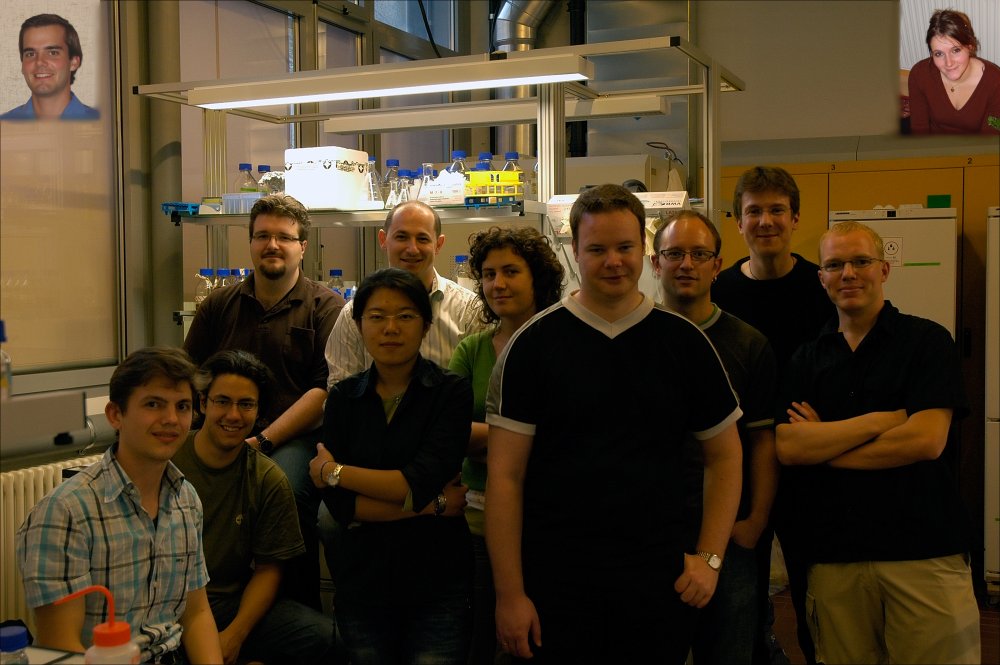ETHZ
From 2007.igem.org
(→Introduction) |
(→Introduction) |
||
| Line 89: | Line 89: | ||
... this is what George Orwell would have written, if he was a synthetic biologist. In the <i>E. coli</i> colonies on petri dishes, all bacteria are equal, except from some special ones. Our project is about modeling and designing these special <i>E. coli</i>'s, that are "more equal" that the rest, having the ability to recognize their environment, and their story will be presented through this wiki... | ... this is what George Orwell would have written, if he was a synthetic biologist. In the <i>E. coli</i> colonies on petri dishes, all bacteria are equal, except from some special ones. Our project is about modeling and designing these special <i>E. coli</i>'s, that are "more equal" that the rest, having the ability to recognize their environment, and their story will be presented through this wiki... | ||
| - | |||
| - | |||
| - | |||
=Motivation= | =Motivation= | ||
Revision as of 22:21, 23 October 2007
Introduction
"All E. coli's are equal, but some E. coli's are more equal than others..." (freely adapted from the Animal Farm by George Orwell)
... this is what George Orwell would have written, if he was a synthetic biologist. In the E. coli colonies on petri dishes, all bacteria are equal, except from some special ones. Our project is about modeling and designing these special E. coli's, that are "more equal" that the rest, having the ability to recognize their environment, and their story will be presented through this wiki...
Motivation
Thereby, the educatETH E.coli 's provide a first step towards the development of biological equivalents to complex engineering building blocks like, e.g. , flip-flops and other logical circuits. We also introduced the concept of double promoters to the [http://partsregistry.org/Main_Page Registry of Standard Biological Parts], which can be helpful for future projects. The concept of learning and recognition plays a major role in different high-level applications like, e.g., recognition of handwriting on a [http://en.wikipedia.org/wiki/Personal_digital_assistant PDA] as well as biological applications. On the other hand, learning plays a major role for living organisms, as well: it enables them to survive by adapting to an ever-changing environment. Therefore, engineering a simple biological system which exhibits learning behavior is of great interest as it can support our understanding of this procedure by comparison with natural systems.
In the following, we would like to present you a detailed description of the proposed system: starting with the modeling of the system, we describe both, simulations and theoretical considerations of the system, as well as the actual implementation using bio-bricks accompanied by our lab notes. Additionally, you find some further information on the team, some more details about ideas we developed before we came up with the system we finally implemented, and some pictures documenting our work.
Team Members
The ETH Zurich team consists of good mixture between biologists and engineering students, we are:
- Undergraduate students: Martin Brutsche, Katerina Dikaiou, Raphael Guebeli, Sylke Hoehnel, Nan Li, Stefan Luzi
- Graduate students: [http://christos.bergeles.net Christos Bergeles], [http://www.tik.ee.ethz.ch/~sop/people/thohm/ Tim Hohm], [http://www.fussenegger.ethz.ch/people/kemmerc Christian Kemmer], Joseph Knight, [http://csb.inf.ethz.ch/people/uhr.html Markus Uhr], [http://www.ricomoeckel.de Rico Möckel]
- Project advisors: [http://www.ipe.ethz.ch/laboratories/bpl/people/panke Sven Panke], [http://csb.inf.ethz.ch/people/stelling.html Joerg Stelling]
For more information about us, visit our Meet the Team page.
Acknowledgments
The idea for the project as well as its implementation was done by the ETH iGEM 2007 team. Still, we would like to thank the people in [http://www.ipe.ethz.ch/laboratories/bpl/index Sven Panke's Lab], especially Andreas Meyer who was always there for us when we had a problem. Additionally, we would like to thank [http://www.facs.ethz.ch Alfredo Franco-Obregóns lab] and Oralea Büchi for the help with the flow cytometry.
We would also like to acknowledge the financial support by [http://europa.eu EU], the [http://www.ethz.ch ETH Zurich], and [http://www.geneart.com GeneArt]:
| [http://europa.eu http://www.tik.ee.ethz.ch/~thohm/EU.gif] | [http://www.ethz.ch http://www.tik.ee.ethz.ch/~thohm/ethlogo.jpg] | [http://www.geneart.com http://www.tik.ee.ethz.ch/~thohm/geneart.gif] |
Site Map
- Modeling of the learning system
- Implementation using flip-flops
- Representation with finite state machines
- Modeling tutorial
- Model simulations and theoretical considerations
- Biological implementation
- Biobricks/parts
- Potential applications and a link to epigenetics
- Lab notes
- Team page
- Pictures
- Other ideas we developed
- others I forgot?
.:: TODOs ::.
- put a fancy picture in the intro
- put all Links to subpages including a short description in the "site map" section
- check if you like the contents of your personal pages

